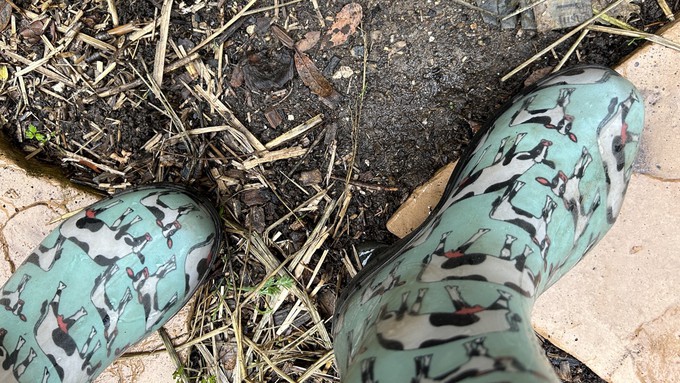
Celebrate and support the amazing structure underfoot

Protect wet soil by not stepping on it. (Stepping stones are especially useful in rainy weather.) And let it dry out a few days before digging in to plant anything. Kathy Morrison
The soil around Sacramento is pretty soggy today, a normal situation for December. We gardeners know not to walk on or dig in soggy soil, which can harm its important structure by destroying microbial relationships and pressing out the air. When it dries, clay soil without air basically is a brick – bad for the gardener, the plants and the soil’s health.
Tuesday, Dec. 5, marked World Soil Day, established to recognize and celebrate the amazing world under our feet. The theme for this year's observance, selected by the United Nations, was “Soil and water, a source of life.”
We can’t underestimate the importance of soil health. Parts of the world have soil that’s been so overworked, eroded or contaminated by heavy metals that it can’t support life, and that’s a tragedy.
So it’s appropriate to appreciate our soil every day. Here are ways to boost and maintain healthy soil at the garden and neighborhood level:
– Minimum tillage. That noisy rototiller is totally unnecessary to planting and harvesting healthy crops. Keep the hand tilling or “double digging” to a minimum, too.
– Crop rotation. Be aware of the plant families, and avoid planting members of the same family in the same spot year after year. Tomatoes, for example, should not be followed by peppers or eggplant, all members of the Solanaceae family. Try garlic (Amaryllidaceae) or spinach (Amaranthaceae) instead.
– Addition of organic matter. Compost, worm castings, aged animal manure, leaves and kelp meal are all appropriate soil amendments. And you don’t even have to dig them in: Spread them across the top of the soil and let the rain (like now!) or irrigation do the work to enhance the soil below it.
– Planting of cover crops. This isn’t called “green manure” for nothing. A cover crop – vetch, clover, bell beans or winter rye, for a few examples – planted now will grow over winter. It then can be cut down in February, raked into the soil and be broken down in time for planting summer vegetables.
Healthy soil also can enhance water infiltration and storage, did you know? The practices mentioned here contribute to carbon sequestration, too. So when we keep the soil healthy, we help the fight against water pollution and climate change. Our world's health starts with what’s underfoot.
Comments
0 comments have been posted.Sacramento Digs Gardening to your inbox.
Sites We Like
Garden Checklist for week of May 12
Get your gardening chores and irrigation done early in the day before temperatures rise.
* Plant, plant, plant! It’s prime planting season in the Sacramento area. Time to set out those tomato transplants along with peppers and eggplants. Pinch off any flowers on new transplants to make them concentrate on establishing roots instead of setting premature fruit.
* Direct-seed melons, cucumbers, summer squash, corn, radishes, pumpkins and annual herbs such as basil.
* Harvest cabbage, lettuce, peas and green onions. This heat will cause leafy greens and onions to flower; pick them before they bolt.
* In the flower garden, direct-seed sunflowers, cosmos, salvia, zinnias, marigolds, celosia and asters.
* Plant dahlia tubers. Other perennials to set out include verbena, coreopsis, coneflower and astilbe.
* Transplant petunias, marigolds and perennial flowers such as astilbe, columbine, coneflowers, coreopsis, dahlias, rudbeckia and verbena.
* Keep an eye out for slugs, snails, earwigs and aphids that want to dine on tender new growth.
* Feed summer bloomers with a balanced fertilizer.
* For continued bloom, cut off spent flowers on roses as well as other flowering plants.
* Got fruit trees? If you haven't already done so, thin orchard fruit such as apples, peaches, pears, pluots and plums before they grow too heavy, breaking branches or even splitting the tree. Leave the largest fruit on the branch, culling the smaller ones, and allow for 5 to 6 inches (or a hand's worth) between each fruit.
* Thin grape bunches, again leaving about 6 inches between them. For the remaining bunches, prune off the "tail" end, about the bottom third of the bunch, so that the plant's energy is concentrated in the fruit closest to the branch.
* As spring-flowering shrubs finish blooming, give them a little pruning to shape them, removing old and dead wood. Lightly trim azaleas, fuchsias and marguerites for bushier plants.
* Add mulch to the garden to help keep that precious water from evaporating. Mulch also cuts down on weeds. But don’t let it mound around the stems or trunks of trees or shrubs. Leave about a 6-inch to 1-foot circle to avoid crown rot or other problems.